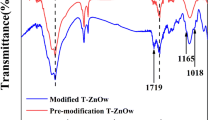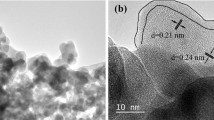Abstract
In this study, the silane-modified polyacrylate latexes for transparent heat insulating coatings were prepared with organic sulfinic acid derivative sodium salt (FF6M) and tert-butyl hydroperoxide (TBHP) used as redox initiators, which avoid the coagulation effect of residual thermal initiator fragments in polymer latexes on functional heat-insulating filler antimony tin oxide (ATO) nanoparticle dispersion. The as-prepared latexes and commercial ATO dispersion were used to construct transparent heat-insulating coatings for building exterior glass. The TGA characterization confirms the thermal stability of nanocomposite coatings was enhanced by introduction of ATO. UV–Vis-IR spectrophotometer verifies that the obtained ATO composite coating films possessed high transparency while shielding 0 ~ 20% IR light. When 6 wt.% ATO was introduced into the coating, the thermal insulation temperature difference is up to 13.1 °C. The prepared transparent heat insulating coatings are employed for building for saving energy consumption and endowing people with a comfortable life.










Similar content being viewed by others
References
EIA J (2021) International Energy Outlook. U.S. Energy Information Administration. https://www.eia.gov/outlooks/ieo/index.php. Accessed 13 May 2022
Rezaei SD, Shannigrahi S, Ramakrishna S (2017) A review of conventional, advanced, and smart glazing technologies and materials for improving indoor environment. Sol Energy Mater Sol Cells 159:26–51. https://doi.org/10.1016/j.solmat.2016.08.026
Cuce E, Cuce PM (2016) Vacuum glazing for highly insulating windows: recent developments and future prospects. Renew Sustain Energy Rev 54:1345–1357. https://doi.org/10.1016/j.rser.2015.10.134
Jelle BP, Kalnæs SE, Gao T (2015) Low-emissivity materials for building applications: a state-of-the-art review and future research perspectives. Energy Build 96:329–356. https://doi.org/10.1016/j.enbuild.2015.03.024
Shen B, Wang Y, Lu L, Yang H (2021) Spraying fabrication of spectrally selective coating with improved near-infrared shielding performance for energy-efficient glazing. Ceram Int 47:18991–18997. https://doi.org/10.1016/j.ceramint.2021.03.243
Xu X (2017) Preparation and overall energy performance assessment of nanoscale transparent thermal insulation coatings (in Chinese). Dissertation, China University of Petroleum
Han T (2013) Preparation of nano-ATO particle and development of waterborne transparent thermal insulation glass coating (in Chinese). Dissertation, South China University of Technology
Hwang H, Park J-H, Kim B-G (2013) Solar-heat-blocking coating solution and solar-heat-blocking coated glass using the same. U.S. Patent No. 13/582,166
Kuno H, Takeda H, Adachi K (2003) Near infra-red shielding single or multilayer film and a coating liquid for forming the same. European Patent No. 1998030888
Nobe M (2021) Dispersion liquid, coating liquid, and heat ray shielding film. U.S. Patent No. 15/780,146
Machida K, Fujita K (2019) Heat ray-shielding particle-containing composition and method of producing the same, heat ray-shielding film, and heat ray-shielding laminated transparent base material. U.S. Patent No. 10,308,801
Mehravar S, Ballard N, Tomovska R, Asua JM (2019) Polyurethane/acrylic hybrid waterborne dispersions: synthesis, properties and applications. Ind Eng Chem Res 58:20902–20922. https://doi.org/10.1021/acs.iecr.9b02324
Zhao W, Shao T, Chen X, Cao S, Chen L (2021) Preparation and characterization of self-crosslinking acrylic emulsion with different fluorocarbon chain lengths. Pigment Resin Technol. https://doi.org/10.1108/PRT-07-2021-0073
Kozakiewicz J, Trzaskowska J, Domanowski W, Kieplin A, Ofat-Kawalec I, Przybylski J, Woźniak M, Witwicki D, Sylwestrzak K (2020) Studies on synthesis and characterization of aqueous hybrid silicone-acrylic and acrylic-silicone dispersions and coatings. Part II. Prog Org Coat 138:105297. https://doi.org/10.1016/j.porgcoat.2019.105297
Aznar AC, Pardini OR, Amalvy JI (2006) Glossy topcoat exterior paint formulations using water-based polyurethane/acrylic hybrid binders. Prog Org Coat 55:43–49. https://doi.org/10.1016/j.porgcoat.2005.11.001
Shao T, Gong Y, Chen X, Chen L (2021) Preparation and characterization of modified self-crosslinking fluorocarbon acrylate latex. Chem Pap 75:853–862. https://doi.org/10.1007/s11696-020-01350-8
Park H-S, Yang I-M, Wu J-P, Kim M-S, Hahm H-S, Kim S-K, Rhee H-W (2001) Synthesis of silicone–acrylic resins and their applications to superweatherable coatings. J Appl Polym Sci 81:1614–1623. https://doi.org/10.1002/app.1592
Tao P, Viswanath A, Schadler LS, Benicewicz BC, Siegel RW (2011) Preparation and optical properties of indium tin oxide/epoxy nanocomposites with polyglycidyl methacrylate grafted nanoparticles. ACS Appl Mater Interfaces 3:3638–3645. https://doi.org/10.1021/am200841n
Ho SM (2016) A review on thin films on indium tin oxide coated glass substrate. Asian J Chem 28:469–472. https://doi.org/10.14233/ajchem.2016.19579
Chen B (2018) Synthesis of dual functional Al-doped ZnO particles for photocatalysis and heat shielding property applications. J Sol-gel Sci Techn 86:198–205. https://doi.org/10.1007/s10971-018-4622-1
Li Y-Q, Kang Y, Xiao H-M, Mei S-G, Zhang G-L, Fu S-Y (2011) Preparation and characterization of transparent Al doped ZnO/epoxy composite as thermal-insulating coating. Compos Part B Eng 42:2176–2180. https://doi.org/10.1016/j.compositesb.2011.05.015
Li S, Zhu P, Zhao T, Sun R (2014) Optical, electrical, and thermal insulation properties of antimony-doped tin oxide nanoparticles prepared by frozen gel method. J Sol-Gel Sci Technol 70:366–370. https://doi.org/10.1007/s10971-014-3291-y
Luo L, Bozyigit D, Wood V, Niederberger M (2013) High-quality transparent electrodes spin-cast from preformed antimony-doped tin oxide nanocrystals for thin film optoelectronics. Chem Mater 25:4901–4907. https://doi.org/10.1021/cm4030149
Xu X, Wang Y, Wang S, Lin L (2017) Antimony doped tin oxide/multi-walled carbon nanotubes: highly near-infrared blocking coating used for heat conservation windows. Energy Procedia 105:4836–4841. https://doi.org/10.1016/j.egypro.2017.03.958
Lu X, Yu G, Tan Q, Hu B, Zhang J, Dong Q (2014) Preparation and characterization of transparent fluorocarbon emulsion doped with antimony tin oxide and TiO2 as thermal-insulating and self-cleaning coating. J Coat Technol Res 11:567–574. https://doi.org/10.1007/s11998-013-9550-y
Jia X, Liu Y, Wu X, Zhang Z (2014) A low temperature situ precipitation route to designing Zn-doped SnO2 photocatalyst with enhanced photocatalytic performance. Appl Surf Sci 311:609–613. https://doi.org/10.1016/j.apsusc.2014.05.118
Mani R, Vivekanandan K, Vallalperuman K (2017) Synthesis of pure and cobalt (Co) doped SnO2 nanoparticles and its structural, optical and photocatalytic properties. J Mater Sci Mater Electron 28:4396–4402. https://doi.org/10.1007/s10854-016-6067-z
Ottofuelling S, Von Der Kammer F, Hofmann T (2011) Commercial titanium dioxide nanoparticles in both natural and synthetic water: comprehensive multidimensional testing and prediction of aggregation behavior. Environ Sci Technol 45:10045–10052. https://doi.org/10.1021/es2023225
Shih Y, Zhuang C, Peng Y-H, Lin C, Tseng Y (2012) The effect of inorganic ions on the aggregation kinetics of lab-made TiO2 nanoparticles in water. Sci Total Environ 435–436:446–452. https://doi.org/10.1016/j.scitotenv.2012.06.076
Kohut-Svelko N, Pirri R, Asua JM, Leiza JR (2009) Redox initiator systems for emulsion polymerization of acrylates. J Polym Sci Part Polym Chem 47:2917–2927. https://doi.org/10.1002/pola.23362
Sarac AS (1999) Redox polymerization. Prog Polym Sci 24:1149–1204. https://doi.org/10.1016/S0079-6700(99)00026-X
Castelvetro V, De Vita C, Giannini G, Malvaldi M (2005) Alkoxysilane functional acrylic latexes: influence of copolymer composition on self-curing behavior and film properties. Macromol Symp 226:289–302. https://doi.org/10.1002/masy.200550826
Vitry S, Mezzino A, Gauthier C, Cavaillé J-Y, Lefebvre F, Bourgeat-Lami É (2003) Hybrid copolymer latexes cross-linked with methacryloxy propyl trimethoxy silane. Film formation and mechanical properties. Comptes Rendus Chim 6:1285–1293. https://doi.org/10.1016/j.crci.2003.07.011
Stutz H, Illers K-H, Mertes J (1990) A generalized theory for the glass transition temperature of crosslinked and uncrosslinked polymers. J Polym Sci Part B Polym Phys 28:1483–1498
Park JM, Jeon JH, Lee YH, Lee DJ, Park H, Chun HH, Do Kim H (2015) Synthesis and properties of UV-curable polyurethane acrylates containing fluorinated acrylic monomer/vinyltrimethoxysilane. Polym Bull 72:1921–1936. https://doi.org/10.1007/s00289-015-1380-x
Chai SL, Jin MM (2009) Morphology and particle size of nanograde polyurethane/polyacrylate hybrid emulsions. J Appl Polym Sci 114:2030–2035. https://doi.org/10.1002/app.30687
Sun Z, Zhang X, Huang H, Fu H, Chen H (2008) Synthesis of acrylate microemulsion modified by alkoxy silane. J Wuhan Univ Technol-Mater Sci Ed 23:212–217. https://doi.org/10.1007/s11595-006-2212-5
Amal R, Coury JR, Raper JA, Walsh WP, Waite TD (1990) Structure and kinetics of aggregating colloidal haematite. Colloids Surf 46:1–19. https://doi.org/10.1016/0166-6622(90)80045-6
French RA, Jacobson AR, Kim B, Isley SL, Penn RL, Baveye PC (2009) Influence of ionic strength, pH, and cation valence on aggregation kinetics of titanium dioxide nanoparticles. Environ Sci Technol 43:1354–1359. https://doi.org/10.1021/es802628n
Peng Y-H, Tso C, Tsai Y, Zhuang C, Shih Y (2015) The effect of electrolytes on the aggregation kinetics of three different ZnO nanoparticles in water. Sci Total Environ 530–531:183–190. https://doi.org/10.1016/j.scitotenv.2015.05.059
Kunz W, Henle J, Ninham BW (2004) ‘Zur Lehre von der Wirkung der Salze’ (about the science of the effect of salts): Franz Hofmeister’s historical papers. Curr Opin Colloid Interface Sci 9:19–37. https://doi.org/10.1016/j.cocis.2004.05.005
Hsu J-P, Liu B-T (1998) Critical coagulation concentration of a colloidal suspension at high particle concentrations. J Phys Chem B 102:334–337. https://doi.org/10.1021/jp971817q
Zhang Z, Zhao L, Li Y, Chu M (2015) A modified method to calculate critical coagulation concentration based on DLVO theory. Math Probl Eng 2015:e317483. https://doi.org/10.1155/2015/317483
Wang J, Zhao X, Wu A, Tang Z, Niu L, Wu F, Wang F, Zhao T, Fu Z (2021) Aggregation and stability of sulfate-modified polystyrene nanoplastics in synthetic and natural waters. Environ Pollut 268:114240. https://doi.org/10.1016/j.envpol.2020.114240
Zhang Y, Chen Y, Westerhoff P, Hristovski K, Crittenden JC (2008) Stability of commercial metal oxide nanoparticles in water. Water Res 42:2204–2212. https://doi.org/10.1016/j.watres.2007.11.036
Campos AFC, Tourinho FA, da Silva GJ, Lara MCFL, Depeyrot J (2001) Nanoparticles superficial density of charge in electric double-layered magnetic fluid: a conductimetric and potentiometric approach. Eur Phys J E 6:29–35. https://doi.org/10.1007/s101890170025
Mészáros R, Jobbik A, Varga G, Bárány S (2019) Electrosurface properties of Na-bentonite particles in electrolytes and surfactants solution. Appl Clay Sci 178:105127. https://doi.org/10.1016/j.clay.2019.105127
Shanthi E, Banerjee A, Chopra KL (1982) Dopant effects in sprayed tin oxide films. Thin Solid Films 88:93–100. https://doi.org/10.1016/0040-6090(82)90330-3
Waugh MR (2011) The synthesis, characterisation and application of transparent conducting thin films. Dissertation, University College London
Wang M, Bu J, Xu Y, Liu Y, Yang Y (2021) Sb-doped SnO2 (ATO) hollow submicron spheres for solar heat insulation coating. Ceram Int 47:547–555. https://doi.org/10.1016/j.ceramint.2020.08.162
Xu X, Zhang W, Hu Y, Wang Y, Lu L, Wang S (2017) Preparation and overall energy performance assessment of wide waveband two-component transparent NIR shielding coatings. Sol Energy Mater Sol Cells 168:119–129. https://doi.org/10.1016/j.solmat.2017.04.032
Acknowledgements
The author thanks the instrument support from South China University of Technology.
Author information
Authors and Affiliations
Contributions
Aojue Ke: conceptualization, methodology, resources, formal analysis, data curation, formal analysis, writing — original draft, visualization. Yiming Lu: formal analysis, writing — review and editing. Ruibin Mo: project administration, writing — review and editing. Weishan Wang: writing—review and editing. Xinya Zhang: supervision, writing — review and editing, validation.
Corresponding author
Ethics declarations
Ethical approval
Not applicable
Competing interests
The authors declare no competing interests.
Additional information
Publisher's Note
Springer Nature remains neutral with regard to jurisdictional claims in published maps and institutional affiliations.
Rights and permissions
Springer Nature or its licensor (e.g. a society or other partner) holds exclusive rights to this article under a publishing agreement with the author(s) or other rightsholder(s); author self-archiving of the accepted manuscript version of this article is solely governed by the terms of such publishing agreement and applicable law.
About this article
Cite this article
Ke, A., Lu, Y., Mo, R. et al. Facile construction of transparent and heat-insulating coatings with ATO nanoparticles and silane-modified polyacrylate latex by redox initiation. Colloid Polym Sci 301, 587–598 (2023). https://doi.org/10.1007/s00396-023-05092-3
Received:
Revised:
Accepted:
Published:
Issue Date:
DOI: https://doi.org/10.1007/s00396-023-05092-3




